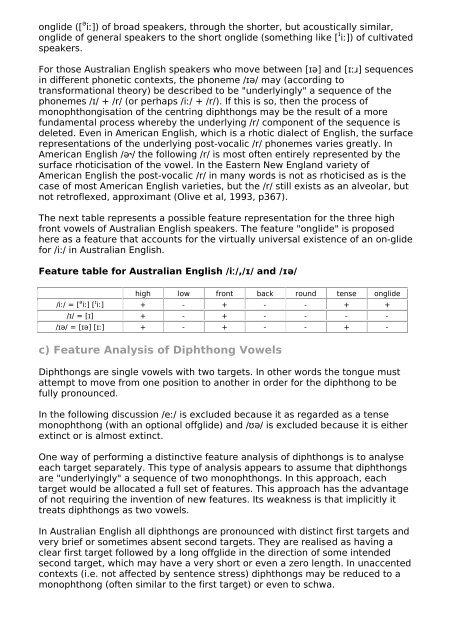Distinctive Features - Speech Resource Pages - Macquarie University
Distinctive Features - Speech Resource Pages - Macquarie University
Distinctive Features - Speech Resource Pages - Macquarie University
Create successful ePaper yourself
Turn your PDF publications into a flip-book with our unique Google optimized e-Paper software.
onglide ([ ə iː]) of broad speakers, through the shorter, but acoustically similar,<br />
onglide of general speakers to the short onglide (something like [ ɪ iː]) of cultivated<br />
speakers.<br />
For those Australian English speakers who move between [ɪə] and [ɪːɹ] sequences<br />
in different phonetic contexts, the phoneme /ɪə/ may (according to<br />
transformational theory) be described to be "underlyingly" a sequence of the<br />
phonemes /ɪ/ + /r/ (or perhaps /iː/ + /r/). If this is so, then the process of<br />
monophthongisation of the centring diphthongs may be the result of a more<br />
fundamental process whereby the underlying /r/ component of the sequence is<br />
deleted. Even in American English, which is a rhotic dialect of English, the surface<br />
representations of the underlying post-vocalic /r/ phonemes varies greatly. In<br />
American English /ə˞/ the following /r/ is most often entirely represented by the<br />
surface rhoticisation of the vowel. In the Eastern New England variety of<br />
American English the post-vocalic /r/ in many words is not as rhoticised as is the<br />
case of most American English varieties, but the /r/ still exists as an alveolar, but<br />
not retroflexed, approximant (Olive et al, 1993, p367).<br />
The next table represents a possible feature representation for the three high<br />
front vowels of Australian English speakers. The feature "onglide" is proposed<br />
here as a feature that accounts for the virtually universal existence of an on-glide<br />
for /i:/ in Australian English.<br />
Feature table for Australian English /iː/,/ɪ/ and /ɪə/<br />
high low front back round tense onglide<br />
/iː/ = [ ə iː] [ ɪ iː] + - + - - + +<br />
/ɪ/ = [ɪ] + - + - - - -<br />
/ɪə/ = [ɪə] [ɪː] + - + - - + -<br />
c) Feature Analysis of Diphthong Vowels<br />
Diphthongs are single vowels with two targets. In other words the tongue must<br />
attempt to move from one position to another in order for the diphthong to be<br />
fully pronounced.<br />
In the following discussion /eː/ is excluded because it as regarded as a tense<br />
monophthong (with an optional offglide) and /ʊə/ is excluded because it is either<br />
extinct or is almost extinct.<br />
One way of performing a distinctive feature analysis of diphthongs is to analyse<br />
each target separately. This type of analysis appears to assume that diphthongs<br />
are "underlyingly" a sequence of two monophthongs. In this approach, each<br />
target would be allocated a full set of features. This approach has the advantage<br />
of not requiring the invention of new features. Its weakness is that implicitly it<br />
treats diphthongs as two vowels.<br />
In Australian English all diphthongs are pronounced with distinct first targets and<br />
very brief or sometimes absent second targets. They are realised as having a<br />
clear first target followed by a long offglide in the direction of some intended<br />
second target, which may have a very short or even a zero length. In unaccented<br />
contexts (i.e. not affected by sentence stress) diphthongs may be reduced to a<br />
monophthong (often similar to the first target) or even to schwa.
















